1993 BUICK CENTURY ESP
[x] Cancel search: ESPPage 6 of 324
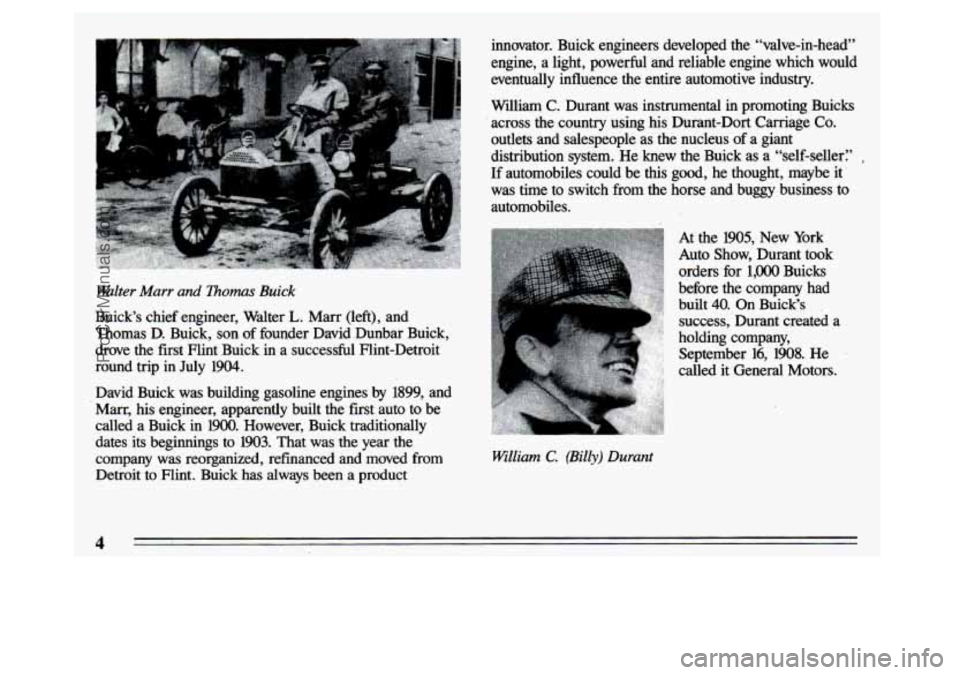
Walter Marr and Thomas Buick
Buick’s chief engineer, Walter L. Marr (left), and
Thomas D. Buick, son. of founder David Dunbar Buick,
drove the first Flint Buick in a successful Flint-Detroit
round trip in July 1904.
David Buick was building gasoline engines by 1899, and
Man,
his engineer, apparently built the first auto to be
called a Buick in 1900. However, Buick traditionally
dates its beginnings to
1903. That was the year the
company was reorganized, refinanced and moved from
Detroit to Flint. Buick has always been a product
4
innovator. Buick engineers developed the “valve-in-head”
engine, a light, powerful and reliable engine which- would
eventually influence the entire automotive industry.
William
C. Durant was instrumental in promoting Buicks
across the country using his Durant-Dort Carriage
Co.
outlets and salespeople as the nucleus of a giant
distribution system. He knew
the Buick as a “self-seller? ,
If automobiles could be this good, he thought, maybe it
was time to switch from the horse and buggy business
to
automobiles.
William C. (Billy) Durant
At the 1905, New York
Auto Show, Durant took orders for 1,OOO Buicks
before the company had
built
40. On Buick’s
success, Durant created a
holding company, September 16, 1908. He
called it General Motors.
ProCarManuals.com
Page 30 of 324
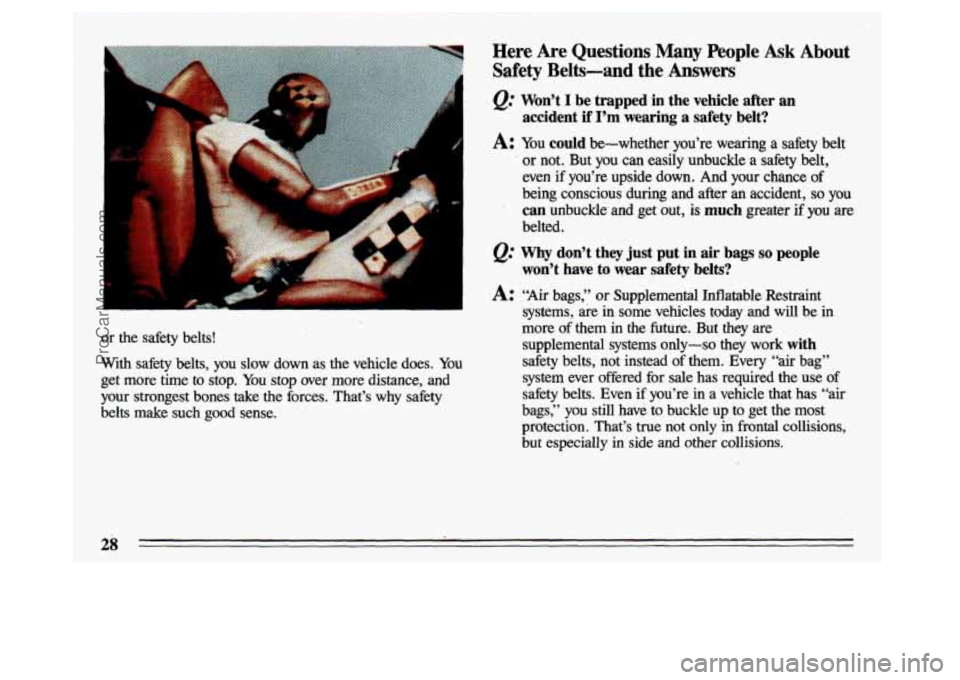
or the safety belts!
With safety belts, you slow down as the vehicle does. You
get more time
to stop. You stop over more distance, and
your strongest bones take the forces. That’s why safety
belts make such good
sense.
Here. Are Questions Many People Ask About
Safety Belts-and the
Answers
@ Won’t I be trapped in the vehicle after an
accident
if I’m wearing a safety belt?
A: You could be-whether you’re wearing a safety belt
or not. But you can easily unbuckle a safety belt,
even if you’re upside down. And your chance of
being conscious during and after an accident,
so you
: can unbuckle and get out, is much greater if you are
belted.
@ Why don’t they just put in air bags so people
A: ‘Air bags,” or Supplemental Inflatable Restraint
won’t have to wear safety belts?
systems, are in some vehicles today and will be in
more of them in the future. But they are
supplemental systems only-so they work
with
safety belts, not instead of them. Every “air bag”
system ever offered for sale has required the use of
safety belts. Even if you’re in a vehicle that has “air \
bags,” you still have to buckle up to get the most
protection. That’s true not
only in frontal collisions,
but especially in side and other collisions.
ProCarManuals.com
Page 67 of 324

I
Door Locks
3
' Unlocked doors can be dangerous.
Passengers-especially children-can easily
open the doors and fall out. When
a door is
locked, the inside handle won't open
it.
Outsiders can easily enter through an
unlocked door when you slow down or stop
your vehicle.
This may not be
so obvious: You Increase the
chance of being thrown out
of the vehicle in a
crash if the doors aren't locked. Wear safety
belts properly, lock your
doors, and you will be
far better
off whenever you drive your vehicle.
There are several ways to
lock and unlock your
vehicle:
From the outside: Use your
door key
or Remote
Keyless Entry transmitter, if your vehicle has this
option.
3
From the inside: To lock
the door, slide the lock
Pqntrol
on the door
"award.
To unlock the door, slide
the lock control forward.
ProCarManuals.com
Page 73 of 324

/r CAUTION:
It can be dangerous to drive with the liftgate or
liftglass open. Carbon monoxide (CO) gas can
come
into your vehicle. You can’t see or smell
CO.
It can cause unconsciousness and even
death.
If you must drive with the liftgate or liftglass
open:
Make sure all other windows are shut.
Turn the fan on your heating or cooling
system
to its highest speed with the setting
on NORM
or VENT. That will force outside air
into your vehicle. See “Comfort Controls’’ in
.the Index.
instrument panel, ope1 hem all the way.
If you have air vents on or under the
Glove Box
Use the door key to lock
and unlock the glove box.
To open, pinch the latch
release.
Theft
Vehicle theft is big business, especially in some cities.
Although
your Buick has a number of theft deterrent
features, we know that nothing we put on it can make it
impossible to steal. However, there are ways you can
help.
Key in the ignition: If you walk away from your vehicle
with the keys inside, it’s an easy target for
joy riders or
professional thieves-so don’t do it. When you park your
Buick and open the driver’s door, you’ll hear
a chime
reminding
you to remove your key from the ignition and
take it with you. Always do this. Your steering wheel will
be locked, and
so will your ignition and transaxle. And
remember to lock the doors.
n
ProCarManuals.com
Page 97 of 324

Lights
Interior Lights/Instrument Panel Intensity Control
I+
Headlights
*P
I PF
You can brighten or dim the
instrument panel lights by
rotating the control up or
down. To turn on the
interior courtesy lights,
rotate the control all the
way up to
“HI:’
Press the switch marked “P” to
turn on:
Parking Lights
Side Marker Lights
Taillights
License Plate Lights
Instrument Panel Lights
-‘(J- Press the , switch to turn on the headlights,
together with:
Parking Lights
Side Marker Lights
Taillights
License Plate Lights
Instrument Panel Lights
Press
“OFF” to turn off the lights.
Operation of Lights
Although your vehicle’s lighting system (headlamps,
parking lamps, fog lamps, side marker lamps’and tail
lamps) meets
all applicable federal lighting requirements,
certain States and Provinces may apply their own lighting
regulations that may require special attention before you
operate these lamps. For example, some jurisdictions
may require that you operate your lower beam lamps
with fog lamps at
all times, or that headlamps be turned
on whenever you must use your windshield wipers.
In
addition, most jurisdictions prohibit driving solely with
parking lamps, especially at dawn or dusk.
It is
recommended that you check with your own State Or
Provincial highway authority for applicable lighting
regulations.
95
ProCarManuals.com
Page 119 of 324
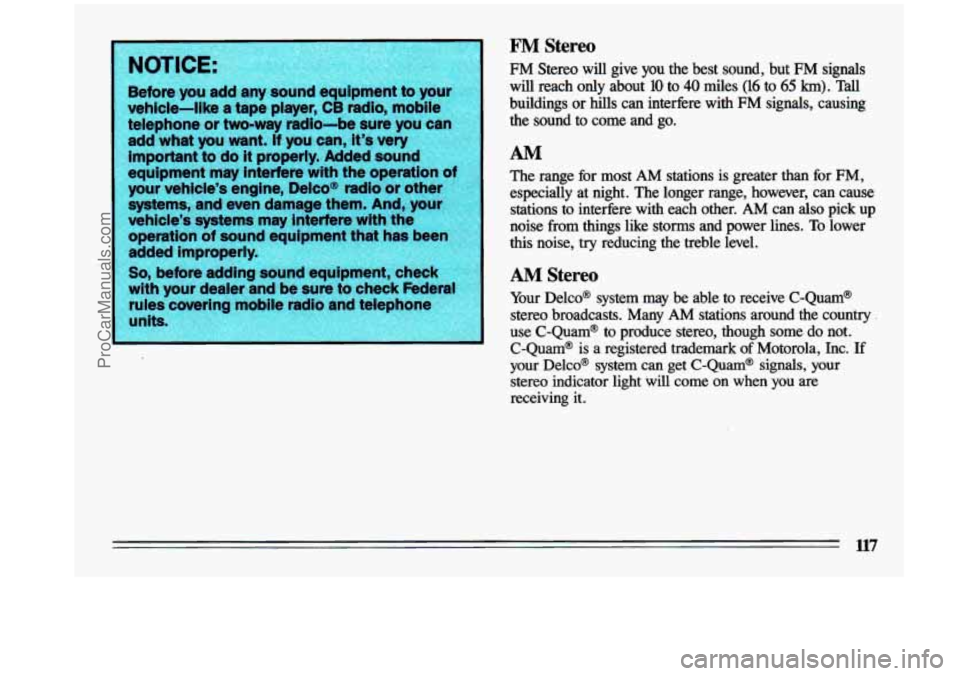
F'M Stereo
FM Stereo will give you the best sound, but FM signals
will reach only about
10 to 40 miles (16 to 65 km). Tall
buildings or hills can interfere with FM signals, causing
the sound to come and go.
AM
The range for most AM stations is greater than for FM,
especially at night. The longer range, however, can cause
stations
to inkfiere with each other. AM can also pick up
noise from things like storms and power lines.
To lower
this noise, try reducing the treble level.
AM Stereo
Your Delco@ system may be able to receive C-Quam@
stereo broadcasts. Many
AM stations around the country
use C-Quam* to produce stereo, though some do not.
C-Quam@ is a registered trademark
of Motorola, Inc. If
your Delco@ system can get C-Quam@ signals, your
stereo indicator light will come on when you are
receiving it.
ProCarManuals.com
Page 147 of 324
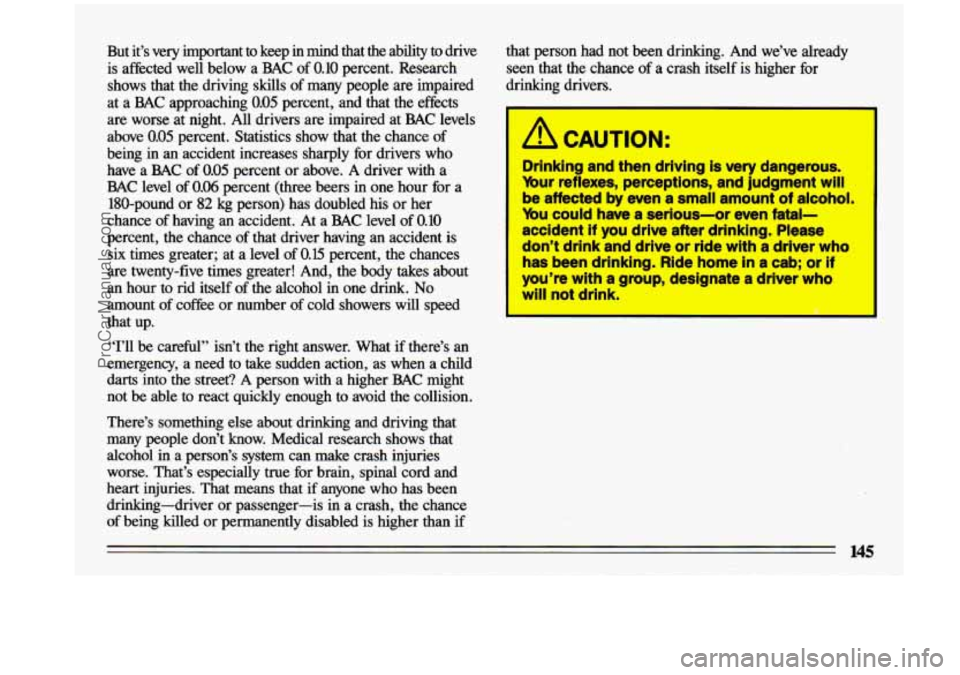
But it’s very important to keep in mind that the ability to drive
is affected well below a BAC of
0.10 percent. Research
shows that the.driving skills of many people
are impaired
at
a BAC approaching 0.05 percent, and that the effects
are worse at night. All drivers are impaired at BAC levels
above
0.05 percent. Statistics show that the chance of
being
in an accident increases sharply for drivers who
have a BAC of
0.05 percent or above. A driver with a
BAC level of
0.06 percent (three beers in one hour for a
180-pound or 82 kg person) has doubled his
or her
chance of having an accident. At a BAC level of
0.10
percent, the chance of that driver having an accident is
six times greater; at a level of
0.15 percent, the chances
are twenty-five times greater! And, the body takes about
an hour to rid itself of the alcohol in one drink. No
amount of coffee or number of cold showers will speed
that up.
“I’ll be careful” isn’t the right answer. What if t\
here’s an
emergency, a need to take sudden action, as when a child
darts into the street?
A person with a higher BAC might
not be able to react quickly enough to avoid the collision.
There’s something else about drinking and driving that
many people don’t know. Medical research shows that alcohol in a person’s system can make crash injuries
worse. That’s especially true for brain, spinal cord and
heart injuries. That means that if anyone who has been
drinking-driver or passenger-is in a crash, the chance
of being killed or permanently disabled is higher than if that person had not been drinking. And we’ve already
seen that the chance of
a crash itself is higher for
drinking drivers.
/i CAUTION:
Drinking and then driving is very dangerous.
Your reflexes, perceptions, and judgment
will
be affected by even a small amou-nt of alcohol.
You could have a serious-or even fatal-
accident
if you drive after drinking. Please
don’t drink and drive or ride with a driver who
has been drinking. Ride home in a cab; or
if
I you’re with a group, designate a driver who
will not drink.
ProCarManuals.com
Page 151 of 324
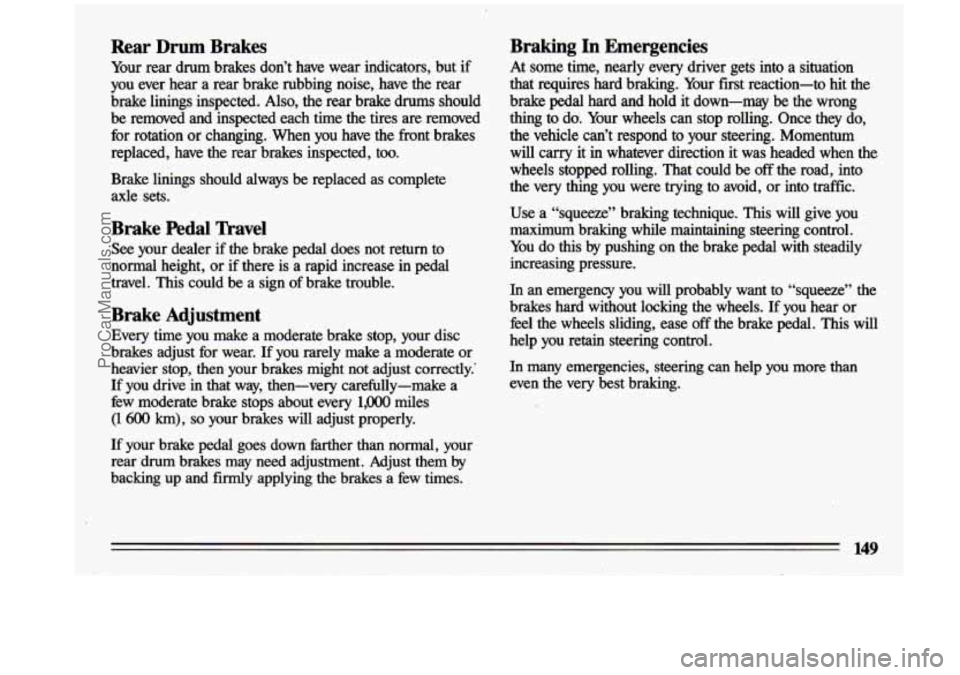
Rear Drum Brakes
Your rear drum brakes don’t have wear indicators, but if
you ever hear a rear brake rubbing noise, have the rear
brake linings inspected.
Also, the rear brake drums should
be removed and inspected each time the tires are removed
for rotation or changing. .When you have the front brakes
replaced, have the rear brakes inspected, too.
Brake linings should always be replaced as complete
axle sets.
Braking In Emergencies
At some time, nearly every driver gets into a situation
that requires hard braking. Your first reaction-to
hit the
brake
pedal hard and hold it down-may be the wrong
thing to do. Your wheels can stop rolling. Once they
do,
the vehicle can’t respond to your steering. Momentum
will carry it
in whatever direction it was headed when the
wheels stopped rolling. That could be
off the road, into
the very thing you were trying
to avoid, or into traffic.
Use a “squeeze” braking technique. This will give you
maximum braking while maintaining steering control.
You do
this by pushing on the brake pedal with steadily
increasing pressure.
Brake Pedal Travel
See your dealer if the brake pedal does not return to
normal height, or if there is a rapid increase in
pedal
travel. This could be a sign of brake trouble.
Brake Adjustment
Every time you make a moderate brake stop, your disc
brakes adjust for wear.
If you rarely make a moderate or
heavier stop, then your brakes might not adjust correctly.’
If you drive in that way, then-very carefully-make a
few moderate brake stops about every
1,0oO miles
(1 600 km), so your brakes will adjust properly.
If your brake pedal goes down farther than normal, your rear drum brakes may need adjustment. Adjust them by
backing up and
firmly applying the brakes a few times. In an emergency you will probably want
to “squeeze”
the
brakes hard without locking the wheels.
If you hear or
feel the wheels sliding, ease off the brake pedal. This will
help you retain steering control.
In many emergencies, steering can help you more than
even the very best braking.
149
ProCarManuals.com